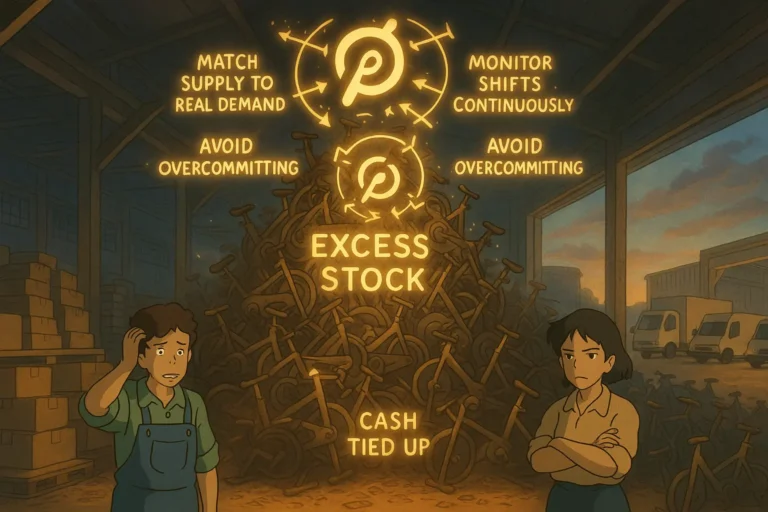
Dead stocks are quite common in African supply chains. There are many reasons why a supply chain suddenly realises it has dead stock, but it primarily happens when there is a failure in inventory management or business operation.
Getting rid of them can be quite an expensive ordeal. In this article, we will explore strategies for getting rid of them, what leads to them, and why it is bad for your supply chain.
What are Dead Stocks?
Simply put, dead stocks are unsellable inventory items. It could be for various reasons, including product expiry, obsolete, out-of-season, or defects. Dead stocks are usually a financial burden for supply chains.
They take up and limit cash flow constraints for the supply chain. A dead stock always certainly means a loss for the supply chain. Getting rid of it is also expensive. The best scenario is to avoid it if the supply chain can totally.
Dead stock can apply to various industries, and getting rid of them typically follows the same strategy.
Dead Stock Calculation
Deadstock is typically calculated as the supply chain’s value or unsellable inventory.
When calculating for dead stocks, there are two solutions African supply chains, and other global supply chains look out for. Dead stock value and dead stock percentage.
Deadstock Value:
This calculation provides the financial impact of deadstock by multiplying the cost per unit by the number of unsold units.
Deadstock Value = Cost per Unit × Quantity of Unsold Units
Example:
Cost per Unit = $300
Quantity of Unsold Units = 8000
Deadstock Value = $300 * 8,000 = $2,400,000
Deadstock Percentage:
This calculation expresses the percentage of the total inventory that constitutes deadstock, providing a relative measure of the impact on the overall inventory.
Deadstock Percentage = ( Quantity of Unsold Units / Total Inventory Quantity ) × 100
Example:
Quantity of Unsold Units = 7,000
Total Inventory Quantity = 300,000
Deadstock Percentage = ( 7,000 / 300,000) × 100 = 2.3%
How to Get Rid of Dead Stocks in African Supply Chains
These are strategies African supply chains can deploy to get rid of dead stocks.
1. Put Items on Sale
When you are stuck with unsellable items, one of the most effective ways to get rid of them is by discounting the items or slashing the price. This way, your supply chain can make some money, even if it is just the cost of the item.
Putting items on sale forces customers to consider the item a steal, especially when they weren’t thinking about buying. For example, selling student school bags for half the price out of season could prompt interest in students who ordinarily would not care.
2. Product Bundles
Another financially effective strategy for getting rid of dead stocks is by packaging the unsellable products and other sellable products as part of a bundle. The trick is to attach these to high-selling products and consider selling at a lower cost.
Customers like a good offer, and when done right, it could help the supply chain quickly sell out its dead stocks. When packaging product bundles, consider the complementary nature of both products.
3. Recycle or Repurpose
If the first two aren’t impossible, you may consider recycling or repurposing the dead stocks. Recycling could mean breaking down the products into their internal components and using them to manufacture different products.
This method saves the supply chain considerable sums in sourcing new products or raw materials. It also helps bridge the gap when the supply chain finds it hard to get relevant raw materials for external reasons.
4. Sell in Bulk
African supply chains can sell dead stocks in bulk to other businesses or supply chains needing them. These are usually businesses willing to repurpose or recycle the products. Selling in bulk is similar to selling on promotions.
The difference is that it is to other businesses, and the price discount is often higher. Selling in bulk usually occurs when the product is defective or expired and is unsafe to sell to consumers.
5. Donate or Give out as a Free Gift
Businesses and supply chains are always looking for avenues to help out the society. Whether it is through impactful lectures, donations, or building infrastructures. These supply chains can donate dead stock to foundations and societies that need it.
However, when doing this, the businesses must ensure the products are completely usable. Otherwise, they will attract negative press and derision from the public, which could impact their sales and other business operations.
6. Try Returning to the Supplier
Suppliers are willing to take back dead stocks depending on the industry and nature of the product. However, in many cases, the supply chain might be responsible for the cost of the reverse logistics.
When this option is available, it might be the best strategy for eliminating the dead stocks, especially for African supply chains or businesses that cannot leverage other strategies.
Why Dead Stocks are Bad for African Supply Chains
Dead stocks are detrimental to your supply chain. Here are some reasons why.
𝟭. 𝗜𝗻𝗰𝗿𝗲𝗮𝘀𝗲𝗱 𝗛𝗼𝗹𝗱𝗶𝗻𝗴 𝗖𝗼𝘀𝘁𝘀: Holding costs are all expenses an inventory commands when it is with the supply chain. This includes the cost of storage, security, insurance, and labour. Holding costs tend to overextend these costs, which limits the cash flow.
𝟮. 𝗦𝘁𝗿𝗮𝗶𝗻 𝗼𝗻 𝗜𝗻𝗳𝗿𝗮𝘀𝘁𝗿𝘂𝗰𝘁𝘂𝗿𝗲: Supply chains do not have unlimited infrastructures. When dead stocks are present, it strains the available infrastructure, such as storage space. They also force to limit production, which impacts sales and supply.
𝟯. 𝗦𝘂𝗽𝗽𝗹𝘆 𝗖𝗵𝗮𝗶𝗻 𝗜𝗻𝗲𝗳𝗳𝗶𝗰𝗶𝗲𝗻𝗰𝗶𝗲𝘀: Dead stocks in African supply chains can be a source of disruption, especially during order fulfilment. It negatively impacts inventory management and lead times.
𝟰. 𝗟𝗶𝗺𝗶𝘁𝗲𝗱 𝗜𝗻𝗻𝗼𝘃𝗮𝘁𝗶𝗼𝗻 𝗮𝗻𝗱 𝗜𝗻𝘃𝗲𝘀𝘁𝗺𝗲𝗻𝘁𝘀: Dead stocks also limit the innovation and investment of the supply chains. This is primarily due to their constraints on the supply chain’s resources and cash flow.
What are the Causes of Dead Stocks in African Supply Chains
There are many behaviours or characteristics that lead to dead stock in African supply chains.
𝟭. 𝗢𝘃𝗲𝗿 𝗢𝗿𝗱𝗲𝗿𝗶𝗻𝗴: This is usually the result of inaccurate demand forecasting and strategies. When supply chains order excess inventory, they find it challenging to sell out quickly, which constitutes a problem for them. Imagine a supply chain stuck with too many umbrellas in a dry season.
𝟮. 𝗗𝗲𝗳𝗲𝗰𝘁𝗶𝘃𝗲 𝗣𝗿𝗼𝗱𝘂𝗰𝘁𝘀: This is often due to product damage or inadequate quality control. This can set the supply chain back significantly because it limits the options of the supply chain. Defective products cannot be given out, and you cannot sell them off as promos to consumers.
𝟯. 𝗢𝗿𝗱𝗲𝗿 𝗖𝗮𝗻𝗰𝗲𝗹𝗹𝗮𝘁𝗶𝗼𝗻𝘀: This usually applies to the pull inventory model and perishable items. When customers cancel orders, it can be challenging for the supply chain if there aren’t new requests to channel the previous orders. When customers order, the supply chain begins producing or preparing, so a cancellation necessitates a big challenge.
𝟰. 𝗟𝗼𝗻𝗴 𝗟𝗲𝗮𝗱 𝗧𝗶𝗺𝗲𝘀: It might be challenging to ensure you have what people want when they want it because trends change frequently. If lead times are lengthy, the demand for the product may have decreased by the time it arrives at your warehouse from your supplier. This ultimately results in dead stocks.
FAQs on Managing Dead Stocks in African Supply Chains
Q1: What steps can African supply chains take to avoid deadstock accumulation?
Supply chains in Africa can avoid the build-up of deadstock by implementing efficient inventory management procedures, keeping an eye on industry developments, carrying out routine audits, and utilizing flexible supply chain tactics that enable them to react rapidly to demand fluctuations.
Q2: How do cultural aspects affect how dead stocks are handled in African markets?
In African nations, cultural influences impact market dynamics and consumer preferences. Acknowledging and integrating these cultural subtleties into inventory control and marketing plans can help prevent deadstock by matching products to regional preferences and interests.
Q3: How can deadstock in African supply chains be reduced through technology?
Data analytics, demand forecasting tools, and sophisticated inventory management systems are ways that technology can be used to its advantage. These tools assist companies in optimizing stock levels, making well-informed judgments, and reacting quickly to market changes.
Conclusion
Dead stocks are detrimental to any supply chain, especially those of African businesses. However, they can be controlled or managed. When you know some of the causes highlighted in the article, you can better tackle them even before they become a problem for the supply chain.

Obinabo Tochukwu Tabansi is a supply chain digital writer (Content writer & Ghostwriter) helping professionals and business owners across Africa learn from real-world supply chain wins and setbacks and apply proven strategies to their own operations. He also crafts social content for logistics and supply chain companies, turning their solutions and insights into engaging posts that drive visibility and trust.







